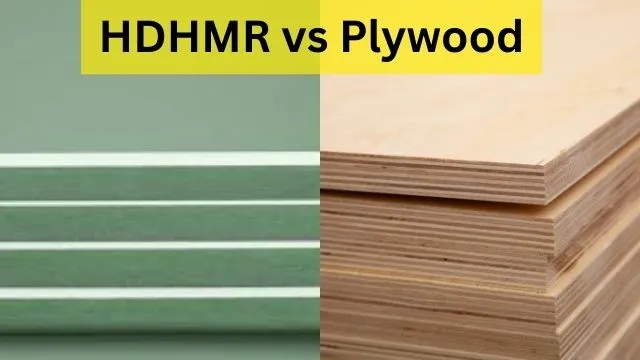Choosing building materials for your projects might be difficult. It’s crucial to choose intelligently with so many possibilities. HDHMR and plywood boards are typical construction and interior design materials. To choose the right engineered wood product for your project, you must grasp their differences and uses.
High-Density High Moisture Resistance (HDHMR) engineered wood products are made by compressing wood fibers, adhesive resins, and wax under high pressure and heat. This manufacturing procedure produces a solid, durable board that resists moisture and humidity. HDHMR is best for high-humidity, occasional-water situations like kitchens and baths.
Another prominent engineered wood product is plywood, manufactured by stacking thin wood veneer sheets with adhesive resins. Cross-grain plywood’s strength, stability, and warping resistance come from its alternating grain orientation.

We will compare HDHMR with plywood’s features, usage, and benefits in this complete comparison. After this investigation, you will be better able to choose the right material for your construction or interior design project.
Understanding HDHMR Board:
Engineered wood products like HDHMR board are made by compressing wood fibers, adhesive resins, and wax under high pressure and heat. This method produces a solid, durable board that resists moisture and humidity, making it appropriate for applications that may be exposed to water or changing humidity.
Key HDHMR Features:
Superior Moisture Resistance
As its name says, HDHMR resists moisture well. Bathrooms, kitchens, and laundry rooms are ideal for it since moisture may degrade wood goods.
Strength and Durability
HDHMR boards are known for their toughness. They can support large weights and resist warping, cracking, and delamination better than plywood.
Surface Smoothness
HDHMR boards are ideal for cabinet manufacturing and furniture construction because they have a smooth, polished finish.
Environmental Concerns
Some HDHMR engineered wood products are manufactured from recycled wood fibers, making them more sustainable than solid wood. However, its adhesive resins may include formaldehyde, which might affect indoor air quality.
Plywood: Definition and Composition
Other prominent engineered wood products include plywood, manufactured by stacking thin wood veneer sheets with adhesive resins. Plywood’s cross-grain structure alternates layer grain orientation, improving strength, stability, and warping resistance.
Key Plywood Features:
Versatility
Plywood is versatile and famous. Its numerous grades and thicknesses make it suitable for structural and ornamental uses.
Plywood is known for its strength and structural integrity. Construction uses it for subflooring, roofing, and wall sheathing since it can take heavy loads.
Dimensional Stability
Unlike solid wood boards, plywood has excellent dimensional stability and seldom warps or twists. It is reliable for flatness projects because to this trait.
Comparisons
Moisture Resistance:
HDHMR boards are suited for areas with high humidity and occasional water exposure due to their moisture resistance. HDHMR’s moisture resistance benefits kitchens and bathrooms, which are moisture-prone. These boards are water- and dampness-resistant, assuring long-term performance.
Although some plywood may be treated to improve moisture resistance, it does not have the same intrinsic moisture resistance as HDHMR. Plywood may need waterproofing to operate better in damp environments. When moisture resistance is required, HDHMR is best.
Strength and Durability:
HDHMR is a strong and durable material that is ideal for furniture and cabinets that need to withstand everyday usage and household weight. The boards are less likely to bend, split, or delaminate than typical plywood, assuring project durability.
Plywood is known for its strength and versatility in structural applications such as subflooring and roofing. Its structural integrity helps structures stand up when employed in construction. Strength makes plywood a versatile material.
Surface Finish:
HDHMR boards are ideal for applications that need a sleek and professional look due to their smooth and uniform surface finish. HDHMR offers a ready-to-finish surface for kitchen cabinets and countertops.
The look of plywood might vary based on variables like wood type and veneer quality. Some plywood varieties need veneer or paint to appear polished and attractive. Customize plywood’s look for your project.
Versatility:
HDHMR is flexible and typically used for indoor applications that need moisture resistance. Its strength and moisture resistance make it ideal for interior applications that need durability and humidity resistance.
Plywood is versatile and has almost no limits. It may be used inside and out for structural and ornamental reasons. Plywood works for subflooring, roofing, external cladding, and ornamental paneling.
Environmental Concerns:
HDHMR sustainability depends on elements like wood fiber supply and adhesive resins used in manufacture. For eco-friendliness, use HDHMR goods with eco-friendly certifications and low-formaldehyde choices. Consider the surroundings before selecting HDHMR.
When made from sustainably managed trees and utilizing low-formaldehyde adhesive resins, plywood may be an eco-friendly option. The Forest Stewardship Council (FSC) certifies the wood’s ethical sourcing and processing. Projects using plywood may emphasize environmental responsibility.
Conclusion: HDHMR vs. Plywood
The decision between HDHMR and plywood depends on your project needs, goals, and budget. The choice between HDHMR and plywood should meet your demands to ensure the success and endurance of your building or interior design project. Consider each material’s benefits and attributes to choose one that fulfills your project’s needs.
In conclusion, HDHMR and plywood are excellent construction materials with distinct benefits. Assess your project’s needs, budget, and environmental impact to identify the best decision. The selection should meet your demands to guarantee the success and durability of your building or interior design project.
Santosh Kumar is a Professional SEO and Blogger, With the help of this blog he is trying to share top 10 lists, facts, entertainment news from India and all around the world.
